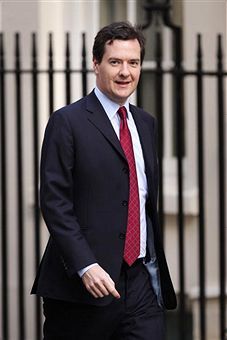 In 2009, Britain borrowed more, as a share of its national income, than any country that
isn’t being bailed out by the IMF and the Eurozone (Greece) or already making drastic spending cuts (Ireland). That huge deficit is the critical challenge to our economic stability that
George Osborne needs to tackle with the Budget today. We have got away with high borrowing so far on the understanding that cuts are coming now the election is out of the way.
In 2009, Britain borrowed more, as a share of its national income, than any country that
isn’t being bailed out by the IMF and the Eurozone (Greece) or already making drastic spending cuts (Ireland). That huge deficit is the critical challenge to our economic stability that
George Osborne needs to tackle with the Budget today. We have got away with high borrowing so far on the understanding that cuts are coming now the election is out of the way.
If you think tax hikes are the answer, then you’re asking the wrong question. Our present fiscal crisis is built on a decade of bumper rises in spending, not tax cuts. Over the last
decade, spending rose from 36.6 per cent of GDP to 53.4 per cent this year according to OECD data. Across the wider developed world, it only increased from 38.7 per cent to 44.8 per cent over
the same period. Taxes have been going up, not down, on a range of activities from driving to work to buying a home to flying on a much needed holiday. Further tax hikes will either be
politically satisfying but economically disastrous – like the 50p rate, which independent forecasters think will lose money – or hit the poor and be a political disaster. The coalition
parties have no mandate for a hike in VAT that would hit the poor twice as hard as the rich. We released a video on the subject yesterday:
By contrast, taking thousands of people out of the income tax system would be an inspiring move, boosting the finances of hard working families and starting to end the absurdity of taking people’s
money in taxes and then giving it back in benefits.
Some people argue that we need to keep deficit-financed spending coming or put economic growth at risk. But, over time, high spending will undermine growth. Research by prominent
economists and researchers at organisations, such as the European Central Bank, has found that higher spending is associated with lower growth. At the TPA, we recently released a research note looking at the implications for the UK economy. The ECB puts the effect at a 0.13 percentage point reduction in
growth for each 1 percentage point rise in spending as a share of national income. Even on the Treasury’s estimate of spending as a share of national income, which is lower than the OECD’s,
the rise since 2000 would be enough to take 1.53 percentage points out of the trend rate of economic growth on that basis.
Yesterday, we released a study based on the Beacon Economic Forecasting Quarterly Macroeconomic Model of the UK and International
Economies (BEFMOD). It sets out the choice facing the Chancellor. With a relatively rapid fiscal adjustment (spending cuts of around £50 billion by next year) the public finances
would improve dramatically. By early 2014 the Chancellor could have room for tax cuts and, by 2020, we could have a budget surplus instead of still being in deficit, and a debt stock of 60.6 per
cent of GDP instead of 94.5 per cent. GDP would be higher and unemployment lower than in the baseline.
So the key question is how the Chancellor of the Exchequer will deliver those cuts in spending. We set out £50 billion of potential cuts in a report with the Institute of Directors last
year and updated that list of cuts for the book How to Cut Public Spending, a short one page summary
of our strategy is available here.
There are some important yardsticks to watch out for. For example, we need to see more organisations scrapped entirely. As former Permanent Secretary Sir Richard Packer wrote in our
book “opposition will be induced more or less whatever the level of the reduction proposed. Certainly the opposition will not be proportional to the level of the reduction”. That means
that scrapping one organisation entirely will create less political opposition than spreading the same pain across several bodies. And scrapping programmes and organisations is the only way of
getting rid of their fixed costs. The Regional Development Agencies, which we released a new research note on yesterday, are one key
test. If the Government are serious about cutting spending then they need to go.
There also needs to be tough action on big budgets like welfare and the public sector pay and pensions bill. Middle class welfare needs to be cut back pending wholesale reform of the welfare
system (a subject the TPA will be looking at in detail in a new report after the Budget). Public sector pay needs to be frozen for more than a year and top earners should face pay cuts as they are
in Ireland.
At the end of the day, a key test of the Budget’s success will be the difference it makes to the growth of the public sector debt interest bill. Without action, families will soon be paying
more for interest on the Government’s debt than on paying their own mortgage.
Tomorrow, at our post-Emergency Budget Briefing, hopefully we’ll be able to report that taxpayers can look
forward to more sustainable public finances and lower taxes.
Matthew Sinclair is Research Director at The Taxpayers’ Alliance





Comments